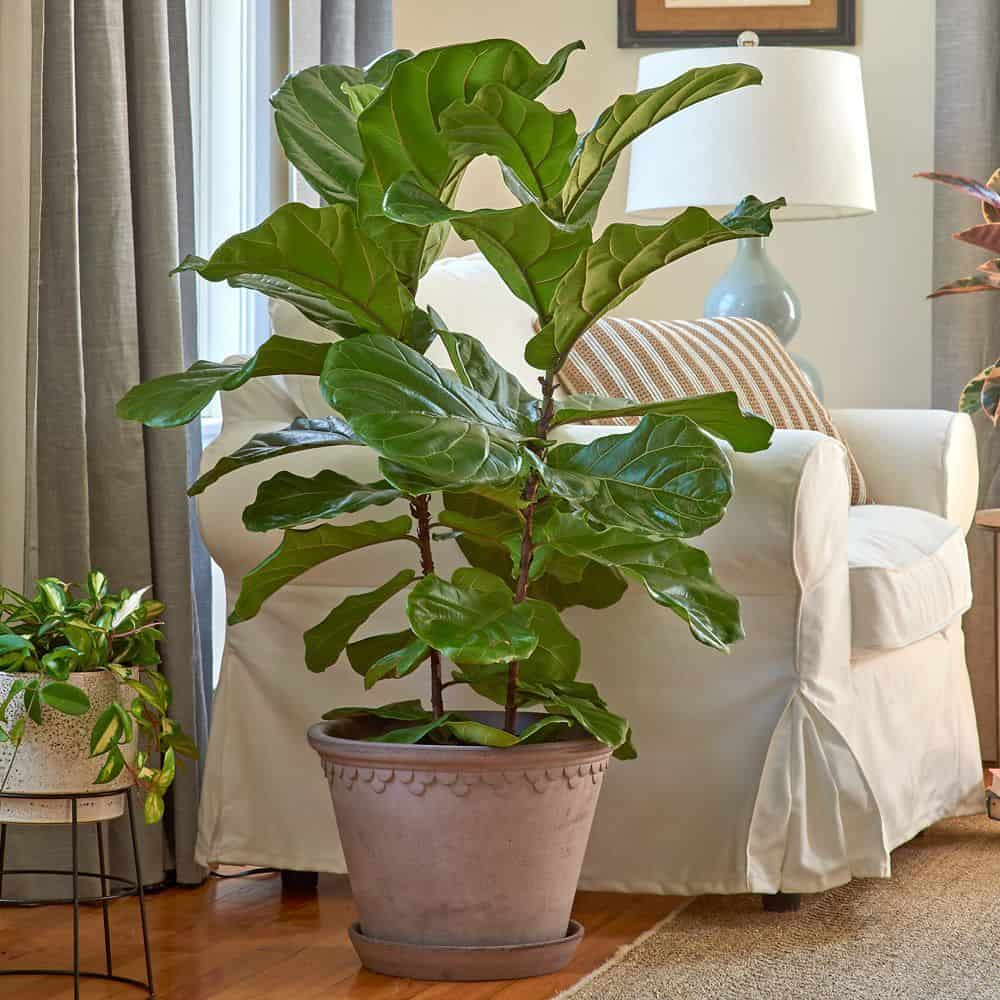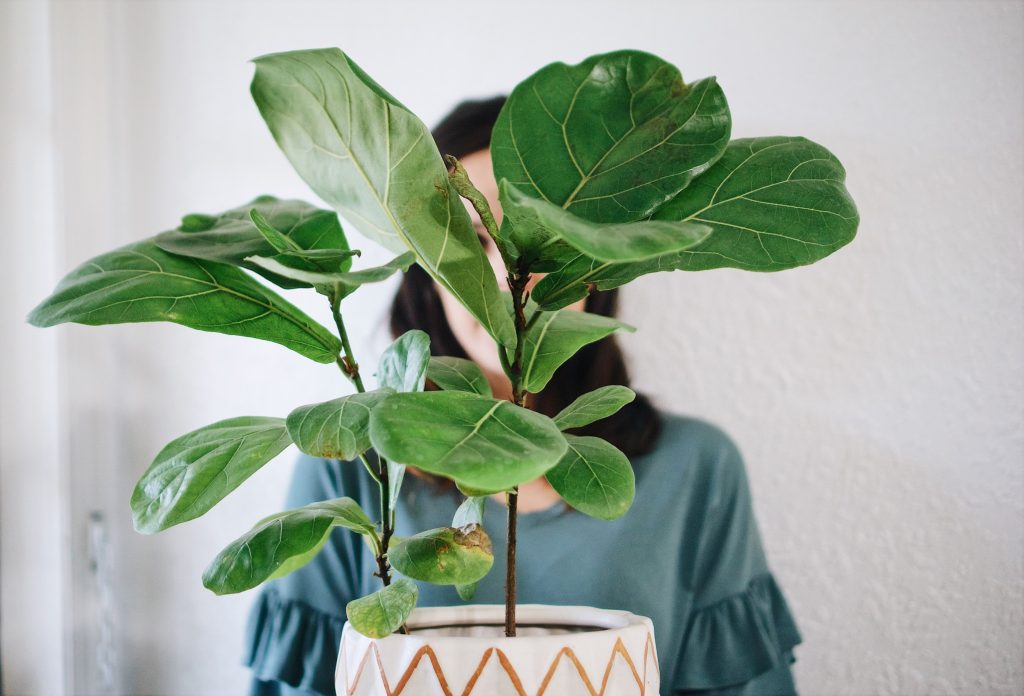Do you enjoy seeing vibrant, lush, and healthy leaves blossom from your fiddle leaf fig, and you, unfortunately, start to notice it drop leaves? Now you searching for the causes and how to fix them.
Leaves and foliage reveal the condition of your plants, it is best to monitor the leaves of your plant and check for any signs, to tell if your plant is healthy or not.
There are several reasons why your fiddle leaf fig is dropping leaves, they include; incorrect watering, chemical burn, lack of humidity, a change in environment, sunburn or improper lighting, root rot, and aging.
It takes constant monitoring, care, and skill to groom your plants to stay healthy and luscious. However, when you notice your plant is dropping leaves or is unhealthy. It is natural to wonder why, as knowing the problem is the best way to find solutions.
Common Reasons Why Your Fiddle Leaf Fig Is Dropping Leaves
The fiddle leaf fig (ficus Lyrata) is a luscious, and commonly used tropical houseplant, found in many homes, or gardens. It has a bold look and adds a natural flair to your home, with its thick glossy leaves. However, it may drop leaves due to stress, change of preferred environment, or lack of proper care.
The common reasons for its drop-in leaves, and the remedies, would be discussed below;
1. Leaf Drop From Shock or Change in Environment
The first common cause of leaf drop in fiddle leaf fig is stress. When you get a new fiddle leaf fig plant, it experiences stress from being moved and placed in a new living atmosphere. Fiddle leaf figs do not like stress or change in the living environment and flourish best in a consistent environment.
If the plant is moved for better humidity or lightning, adjusting to the new environment can also cause stress for the plant. It may take some time for the plant to adjust, but when it does, it should start growing again. During the adjusting phase, it is important to care for and give the plant all it requires to grow.
2. Lack of Humidity or Dry Conditions
Fiddle leaf figs are sensitive to humidity levels, if the air is too dry, it may cause leaf drop. The plant shouldn’t be exposed to direct heating, lighting, or cold air. The plant shouldn’t be kept in an enclosed area, or the doors and windows around them should be kept closed.
It is best to use a humidifier for houseplants where the plant is kept, it is also helpful to make sure the air is not too dry and keep a balanced humidity of 60-75°F around your plant.

3. Incorrect Watering
Another reason for leaf drops is incorrect watering and dry soil. If your plant is not getting enough watering or too much watering, it may lead to leaf drops. There should be a balance in the amount of water for your plant. The soil should not be too dry or waterlogged.
You can stick your finger into the top inch of the soil, to test out, if the soil has proper moisture. If the soil is fairly dry, you can give the plant a generous drink. But if the soil is wet, you shouldn’t water it yet.
A well-draining soil is important, as you do not want your plant sitting in moisture for too long.
4. Fungus Infection (Root Rot)
Root rot occurs when your plant’s soil becomes waterlogged. It is unhealthy for your plant to be over-watered and the soil becomes too wet for a long period of time. It is easily exposed to a fungus infection (Root rot) leading to leaf drops.
To avoid this, keep to a regulated watering schedule, only water when soil is fairly dry, ensure the soil drains out excess moisture, use a quality, well-draining soil mix, and do not overwater.
5. Improper lighting or Sunburn
Plants thrive with proper bright lighting, it is best to place your plant near a window facing south, to absorb proper lighting. However, ensure your plant is not placed or facing direct sunlight, harsh lighting, or exposed to cold air. As this could lead to sunburn and leaf drop.
Instead allow your plant to get plenty of indirect light a day, you can use artificial lighting as well, always ensure your plant isn’t directly facing any lighting.
Always remember not enough lighting leads to leaf drop and too much lighting leads to sunburn and discoloring of leaves.
6. Too Much Fertilizing
We are all aware that fertilizing helps your plant grow and thrive, however when your plant receives too much fertilizing, its leaves would weaken and drop later on. Too much fertilizing blocks out water absorption and causes the plant to grow too fast, only for it weaken after some time.
Instead, it is better to space out fertilizing. Fertilizer during the plants growing season (spring and fall) and do it periodically. Use fertilizers solely healthy to your fiddle leaf figs, and refrain from using generic fertilizers.
7. Chemical Burn
The fiddle leaf fig can be sensitive to harsh pesticides, fungicides, plant insecticides, or harsh detergents, used to combat diseases, pests, or bug infestation. Although you may want to wholly combat any pest and disease infections, it should be done in moderation.
Instead, properly research on any chemical to use on your plant, opt for organic or natural pesticides, and do not place your plant at direct lighting after applying a chemical.

Extra Tip: Fiddle Leaf Figs can experience leaf drop due to aging. This is a natural cause of leaf drop as older leaves towards the bottom of your plant, become too old for the plant to support. It may not show any signs of dying or discoloring.
However, it doesn’t drop in plenty. Other unnatural reasons, can cause the leaf to drop suddenly and in plenty.
Frequently Asked Questions
Is it normal for fiddle leaf figs to drop leaves?
Fiddle leaf figs are ficus, which is evergreen. Thus, it drop leaves, when it is dying, sick or stressed. So it isn’t normal for the leaves of the fiddle leaf fig to drop suddenly and in plenty.
Will leaves grow back from fiddle leaf figs?
Once it sheds a leaf, that node will die and the plant will not regrow the same leaf. Hence, it is important to maintain a healthy, and surviving fiddle leaf fig plant.
Can fertilizers be used on fiddle leaf figs?
Yes, but use fertilizers that are made or healthy for fiddle leaf figs. Avoid using generic fertilizers and opt for organic ones or do a proper research before using any fertilizer.
Conclusion
The fiddle leaf fig is a bold and vibrant tropical houseplant. Therefore, it is important to maintain the plant’s vitality and growth. Hence, when you notice the plant is dropping leaves, there is a reason and you need to combat that reason so your plant can maintain growth.
It is best to water properly, place plants in a humid room, fertilizer when necessary, stay away from harsh pesticides or harsh detergents, and use indirect proper lighting.
Do not fret, if your fiddle leaf figs are dropping leaves, they would eventually recover enough to grow new leaf nodes, and produce new leaves.

